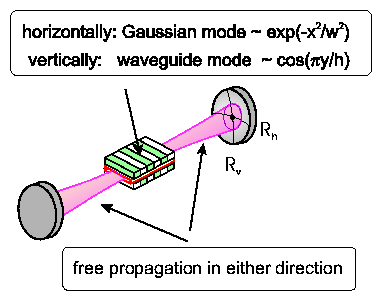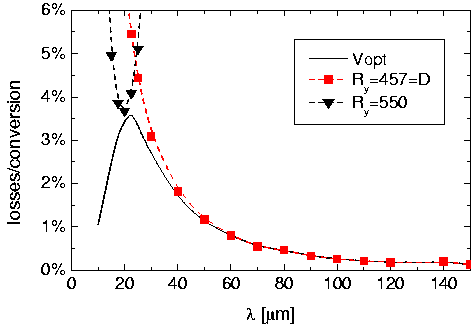|
The undulator U50 [1], which is a long-term loan from the ENEA
Institute in Frascati, should at ELBE provide far infrared radiation up to
roughly 150 mm. Already at 30 mm the transverse
extension of the Gaussian mode in an open resonator is larger than allowed
by the vacuum chamber located inside the undulator, leading to significant losses
of optical power.
To minimize these losses we propose a partially waveguided resonator 10 mm high
that is guiding the wave along the undulator (240 cm) in the vertical dimension
while the chamber is wide enough (40 mm) to allow the propagation of a Gaussian
beam in horizontal direction. The currents induced by such a hybrid mode in
the waveguide walls are small and the resulting ohmic losses are negligible [2].
Outside the undulator the vacuum chamber is large enough to ensure free
propagation in either direction.

Fig. 1 Optical beam in a resonator FEL with a waveguide mode inside the undulator and a Gaussian mode outside of it. The resonator mirrors have different radii of curvature Rh and Rv in the horizontal and vertical plane, respectively.
The results of computation (Fig. 2) show that
at wavelengths larger than 30 mm
the losses can be minimized by a mirror with a fixed radius of curvature Rv
which corresponds to the distance D between mirror and waveguide exit.
Below 30 mm the Fresnel number becomes so large that the appropriate radius of curvature
depends strongly on the wavelength.

Fig. 2 Losses of a single mode conversion in dependence on the wavelength l of the radiation for two different radii of curvature Rv of the mirror. The full line shows the minimum losses which can be obtained with any mirror of constant curvature. 1 Tel Aviv University, Physical Electronics References
[1] F. Ciocci et al., Nucl. Instr. Meth. A 250 (1986) 134-137
|